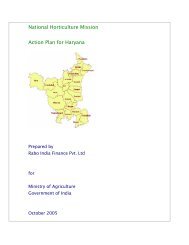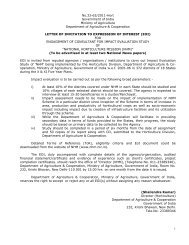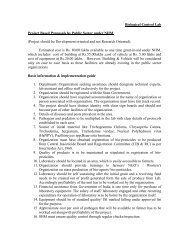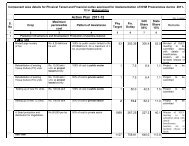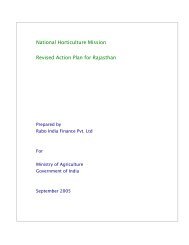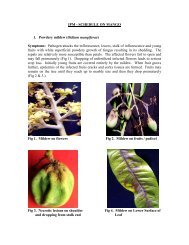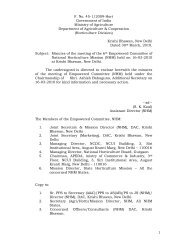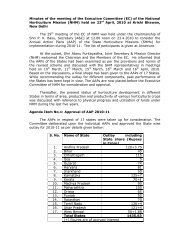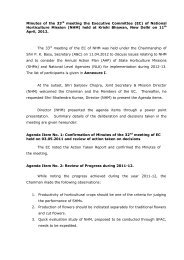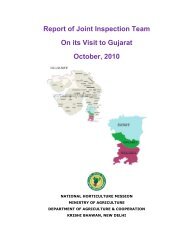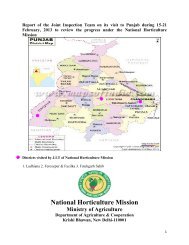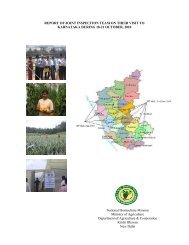Integrated Pest Management Schedule for Vegetables - National ...
Integrated Pest Management Schedule for Vegetables - National ...
Integrated Pest Management Schedule for Vegetables - National ...
You also want an ePaper? Increase the reach of your titles
YUMPU automatically turns print PDFs into web optimized ePapers that Google loves.
<strong>Management</strong>Cut the infected plant parts along with somehealthy portion in morning and carefully collect inpolythene to avoid falling of sclerotia in the field.Burn all these materials away from field.Foliar spray of Carbendazim @ 0.1% at floweringstage followed by spray of mancozeb @ 0.25% incool, cloudy and humid weather.Black moldy growth on foliage<strong>Management</strong>Collect and burn the infected leaves.One spray of hexaconazole or triademefon orbitertanol @ 0.05% at 7-10 days interval.Be careful <strong>for</strong> selecting exotic hybrids andvarieties.White Rot (Sclerotinia sclerotiorum)SymptomsInfection starts during flowering stage. Soft, wet, watersoaked rotting of stem, leaves, fruits, and flowers areobserved followed by white fungal growth over it.This mycelium develops honeydew stage soon aftercolonization. Later on after drying, the entire portionis converted into compact mycelial mat followed byhard sclerotial body. Fruits are severely affected wheresclerotia <strong>for</strong>med inside and outside of the fruits.The disease is observed in December to Januaryduring low temperature, cloudy weather and highatmospheric humidity accompanied by soil moisture.Fruit RotsSeveral fruit rotting pathogens viz. Pythium andPhytophthora affect green fruits while Rhizoctonia,Myrothecium, Colletotrichum, Phomopsis, Alternariaand Cladosporium affect matured fruits. Average40% yield loss is recorded every year due to fruit rotpathogen.SymptomsMyrothecium fruit rot on green as well as ripe fruitappeared as water soaked rotting with prominentconcentric zonation. White to black numerous bodieswere observed on each rings of rotting. Rhizoctoniafruit rot is most serious disease of kharif tomato.Symptoms appear as rhythmic rotting of fruitscoming with the soil contact. Rotting is immediatelyfollowed by cracking and fungal growth over it.Buckeye fruit rot caused by Phytophthora parasiticawas observed mostly in green fruits. Symptoms ofripe fruit rot caused by Colletorichum coccodes werealso observed, as black, dry and corky rotting withacervuli over it. Sclerotium fruit rot is very clear dueto white fungal mycelium and mustard grain likesclerotia over fruits. Sclerotinia fruit rot is havingbigger and irregular sclerotia over it. Generally lowerportion of fruits are infected which are coming in soilcontact.Sclerotinia on fruits rotRhizoctonia fruit rotMyrothecium fruit rotDISEASE MANAGEMENT/TOMATO25



